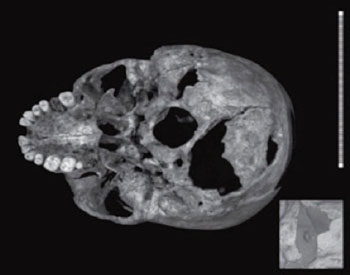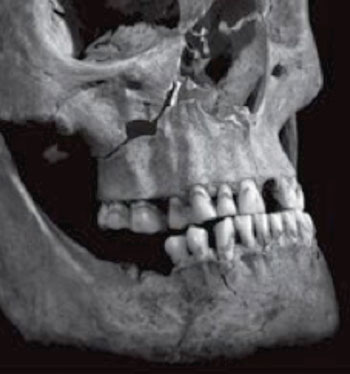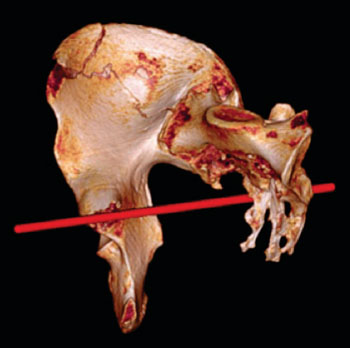Whole Body, Micro-CT Scan Techniques Identify Probable Cause of English King’s Death
|
By MedImaging International staff writers Posted on 06 Oct 2014 |

Image: Inferior aspect of the skull; digital photograph with a micro-CT inset of the penetrating injury, with associated inner table injury (arrow). Scale in mm; a = large sharp-force trauma with bone fragment that could be refitted for imaging; b = penetrating injury (Photo courtesy of the Lancet).

Image: Facial skeleton digital photograph; arrow shows the penetrating injury to the maxilla (Photo courtesy of the Lancet).

Image: Reconstructed right hemi-pelvis and sacrum post-mortem CT using Osirix. Red line shows estimated direction of sharp-force trauma (Photo courtesy of the Lancet).
A team of forensic imaging investigators used whole body computed tomography (CT) scans and micro-CT imaging of injured bones to analyze trauma to the English King Richard III’s 500-year-old skeleton carefully, and to determine which of the king’s wounds might have been fatal. Richard was the last English monarch to perish in battle.
The remains of the king were found under a car park in Leicester, UK by archaeologists. The forensic imaging researchers, working with the forensic pathology unit and the department of Engineering at the University of Leicester (UK), used whole-body CT scans and micro-CT imaging of injured bones to analyze trauma to the 500-year-old skeleton carefully, and to determine which of the King’s wounds might have proved lethal. They also studied tool marks on bone to identify the medieval weapons potentially responsible for his injuries.
The findings, published September 17, 2014, in the Lancet, revealed that Richard’s skeleton bore 11 wounds at or close to the time of his death—nine of them to the skull, distinctly sustained in battle and suggesting he had removed or lost his helmet, and two to the postcranial skeleton.
Sarah Hainsworth, study author and professor of materials engineering at the University of Leicester, explained, “Richard’s injuries represent a sustained attack or an attack by several assailants with weapons from the later medieval period. The wounds to the skull suggest that he was not wearing a helmet, and the absence of defensive wounds on his arms and hands indicate that he was otherwise still armored at the time of his death.”
The investigators, led by Dr. Jo Appleby, from the University of Leicester School of Archaeology and Ancient History, deduced that the postcranial injuries, including the possibly fatal one to the pelvis, might have been inflicted after Richard’s death, on the basis that had he been alive he would have been wearing a specific type of armor worn in the late 15th century that would have prevented such wounds.
According to Prof. Guy Rutty, study coauthor, from the East Midlands pathology unit at the University of Leicester, “The most likely injuries to have caused the King's death are the two to the inferior aspect of the skull—a large sharp force trauma possibly from a sword or staff weapon, such as a halberd or bill, and a penetrating injury from the tip of an edged weapon. The Richard’s head injuries are consistent with some near-contemporary accounts of the battle, which suggest that Richard abandoned his horse after it became stuck in a mire and was killed while fighting his enemies.”
Commenting on the research, Dr. Heather Bonney from the Natural History Museum (London, UK), said, “Appleby and colleagues provide a compelling account, giving tantalizing glimpses into the validity of the historic accounts of his death, which were heavily edited by the Tudors in the following 200 years. Wherever his remains are again laid to rest, I am sure that Richard III will continue to divide opinion fiercely for centuries to come.”
Related Links:
University of Leicester
The remains of the king were found under a car park in Leicester, UK by archaeologists. The forensic imaging researchers, working with the forensic pathology unit and the department of Engineering at the University of Leicester (UK), used whole-body CT scans and micro-CT imaging of injured bones to analyze trauma to the 500-year-old skeleton carefully, and to determine which of the King’s wounds might have proved lethal. They also studied tool marks on bone to identify the medieval weapons potentially responsible for his injuries.
The findings, published September 17, 2014, in the Lancet, revealed that Richard’s skeleton bore 11 wounds at or close to the time of his death—nine of them to the skull, distinctly sustained in battle and suggesting he had removed or lost his helmet, and two to the postcranial skeleton.
Sarah Hainsworth, study author and professor of materials engineering at the University of Leicester, explained, “Richard’s injuries represent a sustained attack or an attack by several assailants with weapons from the later medieval period. The wounds to the skull suggest that he was not wearing a helmet, and the absence of defensive wounds on his arms and hands indicate that he was otherwise still armored at the time of his death.”
The investigators, led by Dr. Jo Appleby, from the University of Leicester School of Archaeology and Ancient History, deduced that the postcranial injuries, including the possibly fatal one to the pelvis, might have been inflicted after Richard’s death, on the basis that had he been alive he would have been wearing a specific type of armor worn in the late 15th century that would have prevented such wounds.
According to Prof. Guy Rutty, study coauthor, from the East Midlands pathology unit at the University of Leicester, “The most likely injuries to have caused the King's death are the two to the inferior aspect of the skull—a large sharp force trauma possibly from a sword or staff weapon, such as a halberd or bill, and a penetrating injury from the tip of an edged weapon. The Richard’s head injuries are consistent with some near-contemporary accounts of the battle, which suggest that Richard abandoned his horse after it became stuck in a mire and was killed while fighting his enemies.”
Commenting on the research, Dr. Heather Bonney from the Natural History Museum (London, UK), said, “Appleby and colleagues provide a compelling account, giving tantalizing glimpses into the validity of the historic accounts of his death, which were heavily edited by the Tudors in the following 200 years. Wherever his remains are again laid to rest, I am sure that Richard III will continue to divide opinion fiercely for centuries to come.”
Related Links:
University of Leicester
Latest Radiography News
- World's Largest Class Single Crystal Diamond Radiation Detector Opens New Possibilities for Diagnostic Imaging
- AI-Powered Imaging Technique Shows Promise in Evaluating Patients for PCI
- Higher Chest X-Ray Usage Catches Lung Cancer Earlier and Improves Survival
- AI-Powered Mammograms Predict Cardiovascular Risk
- Generative AI Model Significantly Reduces Chest X-Ray Reading Time
- AI-Powered Mammography Screening Boosts Cancer Detection in Single-Reader Settings
- Photon Counting Detectors Promise Fast Color X-Ray Images
- AI Can Flag Mammograms for Supplemental MRI
- 3D CT Imaging from Single X-Ray Projection Reduces Radiation Exposure
- AI Method Accurately Predicts Breast Cancer Risk by Analyzing Multiple Mammograms
- Printable Organic X-Ray Sensors Could Transform Treatment for Cancer Patients
- Highly Sensitive, Foldable Detector to Make X-Rays Safer
- Novel Breast Cancer Screening Technology Could Offer Superior Alternative to Mammogram
- Artificial Intelligence Accurately Predicts Breast Cancer Years Before Diagnosis
- AI-Powered Chest X-Ray Detects Pulmonary Nodules Three Years Before Lung Cancer Symptoms
- AI Model Identifies Vertebral Compression Fractures in Chest Radiographs
Channels
MRI
view channel
AI Tool Predicts Relapse of Pediatric Brain Cancer from Brain MRI Scans
Many pediatric gliomas are treatable with surgery alone, but relapses can be catastrophic. Predicting which patients are at risk for recurrence remains challenging, leading to frequent follow-ups with... Read more
AI Tool Tracks Effectiveness of Multiple Sclerosis Treatments Using Brain MRI Scans
Multiple sclerosis (MS) is a condition in which the immune system attacks the brain and spinal cord, leading to impairments in movement, sensation, and cognition. Magnetic Resonance Imaging (MRI) markers... Read more
Ultra-Powerful MRI Scans Enable Life-Changing Surgery in Treatment-Resistant Epileptic Patients
Approximately 360,000 individuals in the UK suffer from focal epilepsy, a condition in which seizures spread from one part of the brain. Around a third of these patients experience persistent seizures... Read moreUltrasound
view channel.jpeg)
AI-Powered Lung Ultrasound Outperforms Human Experts in Tuberculosis Diagnosis
Despite global declines in tuberculosis (TB) rates in previous years, the incidence of TB rose by 4.6% from 2020 to 2023. Early screening and rapid diagnosis are essential elements of the World Health... Read more
AI Identifies Heart Valve Disease from Common Imaging Test
Tricuspid regurgitation is a condition where the heart's tricuspid valve does not close completely during contraction, leading to backward blood flow, which can result in heart failure. A new artificial... Read moreNuclear Medicine
view channel
Novel Radiolabeled Antibody Improves Diagnosis and Treatment of Solid Tumors
Interleukin-13 receptor α-2 (IL13Rα2) is a cell surface receptor commonly found in solid tumors such as glioblastoma, melanoma, and breast cancer. It is minimally expressed in normal tissues, making it... Read more
Novel PET Imaging Approach Offers Never-Before-Seen View of Neuroinflammation
COX-2, an enzyme that plays a key role in brain inflammation, can be significantly upregulated by inflammatory stimuli and neuroexcitation. Researchers suggest that COX-2 density in the brain could serve... Read moreGeneral/Advanced Imaging
view channel
AI-Powered Imaging System Improves Lung Cancer Diagnosis
Given the need to detect lung cancer at earlier stages, there is an increasing need for a definitive diagnostic pathway for patients with suspicious pulmonary nodules. However, obtaining tissue samples... Read more
AI Model Significantly Enhances Low-Dose CT Capabilities
Lung cancer remains one of the most challenging diseases, making early diagnosis vital for effective treatment. Fortunately, advancements in artificial intelligence (AI) are revolutionizing lung cancer... Read moreImaging IT
view channel
New Google Cloud Medical Imaging Suite Makes Imaging Healthcare Data More Accessible
Medical imaging is a critical tool used to diagnose patients, and there are billions of medical images scanned globally each year. Imaging data accounts for about 90% of all healthcare data1 and, until... Read more
Global AI in Medical Diagnostics Market to Be Driven by Demand for Image Recognition in Radiology
The global artificial intelligence (AI) in medical diagnostics market is expanding with early disease detection being one of its key applications and image recognition becoming a compelling consumer proposition... Read moreIndustry News
view channel
GE HealthCare and NVIDIA Collaboration to Reimagine Diagnostic Imaging
GE HealthCare (Chicago, IL, USA) has entered into a collaboration with NVIDIA (Santa Clara, CA, USA), expanding the existing relationship between the two companies to focus on pioneering innovation in... Read more
Patient-Specific 3D-Printed Phantoms Transform CT Imaging
New research has highlighted how anatomically precise, patient-specific 3D-printed phantoms are proving to be scalable, cost-effective, and efficient tools in the development of new CT scan algorithms... Read more
Siemens and Sectra Collaborate on Enhancing Radiology Workflows
Siemens Healthineers (Forchheim, Germany) and Sectra (Linköping, Sweden) have entered into a collaboration aimed at enhancing radiologists' diagnostic capabilities and, in turn, improving patient care... Read more




















